Discover the perfect blend of performance and comfort with ski boots designed to enhance your skiing experience, so you can carve the slopes with confidence and precision.

When it comes to hitting the slopes and enjoying the thrill of skiing, the right gear can make all the difference, and at the core of that gear is your ski boots.
Ski boots are the unsung heroes of your winter adventure, serving as the critical interface between you and the mountain. In this post, we'll explore the world of ski boots, delving into the top options that offer the perfect blend of comfort, performance, and style to elevate your skiing experience.
Whether you're a seasoned expert chasing powder stashes or a novice eager to carve your first turns, this guide to the best ski boots will ensure that your feet are well-prepared for whatever the mountain has in store, so you can make the most of your time on the slopes.
Top 3 Ski Boots
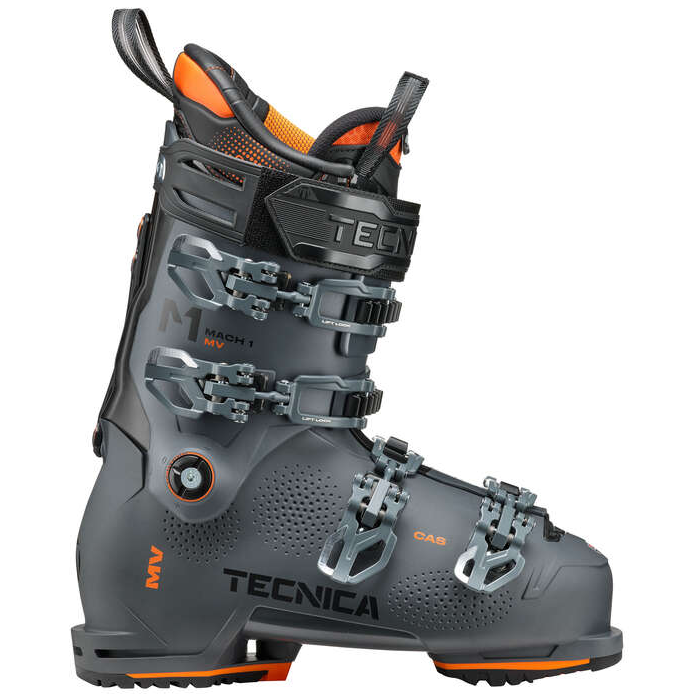
#1st Rated
Tecnica Mach 1 MV 110
The Tecnica Mach 1 MV 110 is an all-mountain high-performance ski boot designed for advanced level skiers with medium volume feet. It features a 110 flex rating, which provides a good balance of power and control without being too stiff. The boot is also relatively lightweight, making it easier to maneuver skis and ski all day long.

#2nd Rated
K2 Men's Mindbender 120 BOA
The K2 Mindbender 120 BOA is a versatile alpine touring ski boot that is perfect for advanced to expert skiers. It features a stiff 120 flex index, which provides excellent power and responsiveness for charging down the mountain. The boot is also relatively lightweight, making it ideal for touring and backcountry adventures.
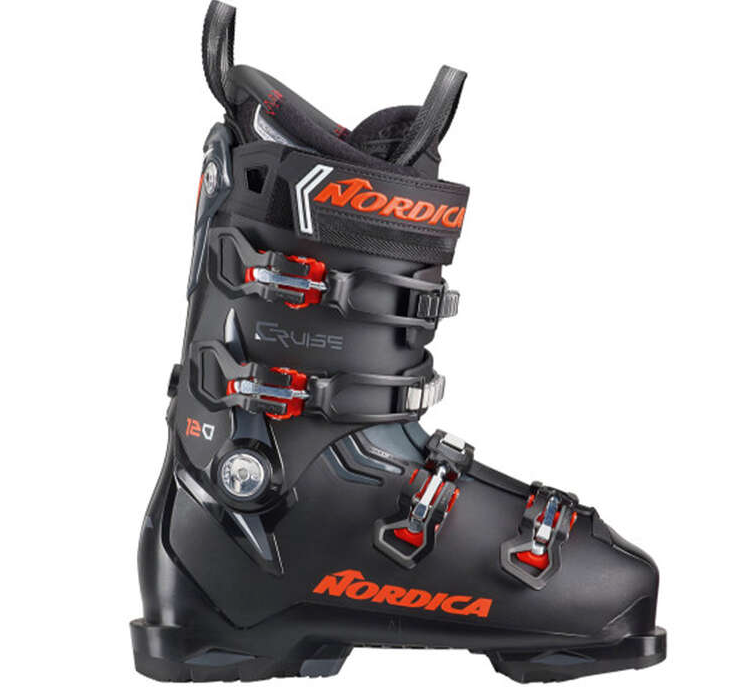
#3rd Rated
Nordica Cruise 120
The Cruise 120 features a number of technologies that make it comfortable and supportive, even for long days on the slopes. The Primaloft® insulation helps to keep your feet warm, while the Performance Fit Liner is fully heat-moldable to provide a custom fit. The Instep Volume Control (IVC) system allows you to adjust the fit of the instep area in seconds.
1) Tecnica Mach 1 MV 110

The Tecnica Mach 1 MV 110 is an all-mountain high-performance ski boot designed for advanced level skiers with medium volume feet. It features a 110 flex rating, which provides a good balance of power and control without being too stiff. The boot is also relatively lightweight, making it easier to maneuver skis and ski all day long.
One of the key features of the Mach 1 MV 110 is T-Drive technology. This revolutionary shell to cuff connection creates a stronger and more effective connection between the two pieces of the boot, resulting in a smoother, more consistent flex. T-Drive also allows the use of softer plastics, which makes the boot easier to get on and off without compromising performance.
Flex
The flex index of the Tecnica Mach 1 MV 110 is 110, which means it is fairly stiff and responsive. It can handle high speeds and aggressive turns, but it is not as demanding or rigid as some other boots with higher flex ratings. The flex can also be adjusted by changing the position of the rear screw on the spine of the boot.
Fit and Comfort

The Tecnica Mach 1 MV 110 is known for its excellent fit and comfort. It is designed with an anatomical shape that matches the contours of the foot, and the C.A.S. technology allows the shell and liner to be customized to the skier's individual foot.
The boot also has a number of other features that contribute to its comfort, including:
- A plush liner made with dual-density microcell material that is both supportive and forgiving
- A wide toe box that gives the toes plenty of room to spread out
- A heat-moldable tongue that can be customized to the skier's foot
- A variety of adjustable buckles and straps that allow the skier to fine-tune the fit
Overall, the Tecnica Mach 1 MV 110 is a very comfortable boot. It is a good choice for skiers who have wide feet or who are prone to foot pain. It is also a good choice for skiers who want a boot that they can wear comfortably all day long, even on long ski days.
Liner Material
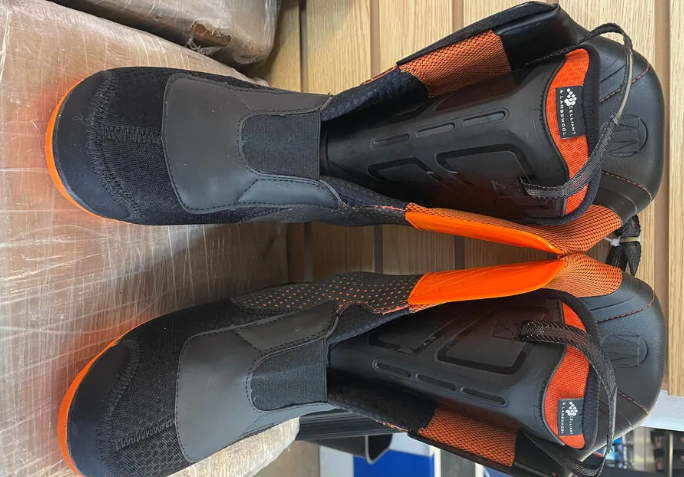
The Tecnica Mach 1 MV 110 liner is made with dual-density microcell material. This material is both supportive and forgiving, providing a comfortable fit and good performance.
The dual-density microcell material is also durable and resistant to packing out. This means that the liner will retain its shape and fit over time, even after heavy use.
The liner is also heat-moldable, which means that it can be customized to the skier's individual foot. This is done by heating the liner in an oven and then putting it on the skier's foot. The liner will then conform to the shape of the skier's foot as it cools.
Overall, the dual-density microcell material is a great choice for ski boot liners. It is comfortable, supportive, durable, and customizable.
Here are some of the benefits of dual-density microcell material:
- It is comfortable and supportive, providing a good fit and performance.
- It is durable and resistant to packing out, so it will retain its shape and fit over time.
- It is heat-moldable, so it can be customized to the skier's individual foot.
If you are looking for a ski boot liner that is comfortable, supportive, durable, and customizable, then the Tecnica Mach 1 MV 110 liner is a great option.
Closure System
The Tecnica Mach 1 MV 110 has a four-buckle closure system. The buckles are made of aluminum and have a lift-lock mechanism that makes them easy to open and close, even with gloves on. The buckles are also micro-adjustable, so you can fine-tune the fit of the boot.
In addition to the four buckles, the Mach 1 MV 110 also has a 45mm power strap. The power strap wraps around the top of the boot and provides additional power and support. The power strap is also adjustable, so you can customize it to your liking.
The closure system on the Mach 1 MV 110 is designed to provide a secure and comfortable fit. The four buckles and power strap work together to keep your foot in place and prevent heel slippage. The closure system is also easy to use, even with gloves on.
Here are some of the benefits of the closure system on the Tecnica Mach 1 MV 110:
- It is secure and comfortable, providing a good fit and performance.
- It is easy to use, even with gloves on.
- The buckles are micro-adjustable, so you can fine-tune the fit of the boot.
- The power strap provides additional power and support.
If you are looking for a ski boot with a secure and comfortable closure system, then the Tecnica Mach 1 MV 110 is a great option.
Sole Type
The Tecnica Mach 1 MV 110 comes with GripWalk soles. GripWalk soles are a type of alpine DIN (ISO 5355) sole that is designed to provide better traction and comfort when walking off the slopes.
GripWalk soles have a convex shape, which gives them more surface area to grip the snow and ice. They also have a rockered profile, which makes it easier to walk in them.
GripWalk soles are compatible with GripWalk bindings. GripWalk bindings are designed to accommodate the convex shape of GripWalk soles.
Here are some of the benefits of GripWalk soles:
- They provide better traction and comfort when walking off the slopes.
- They are compatible with GripWalk bindings.
- They are durable and resistant to wear and tear.
If you are looking for a ski boot with soles that will provide good traction and comfort when walking off the slopes, then the Tecnica Mach 1 MV 110 with GripWalk soles is a great option.
Boot Width and Last
The boot width and last of the Tecnica Mach 1 MV 110 are based on the medium volume (MV) last, which has a width of 100 mm at the forefoot. This last is designed to fit skiers with average feet who do not need too much room or too much compression in their boots.
Weight
The weight of the Tecnica Mach 1 MV 110 is about 1800 grams per boot at size 26.5. This weight is relatively light for a boot with this level of performance and customization.
2) K2 Mindbender 120 BOA

The K2 Mindbender 120 BOA is a versatile alpine touring ski boot that is perfect for advanced to expert skiers. It features a stiff 120 flex index, which provides excellent power and responsiveness for charging down the mountain. The boot is also relatively lightweight, making it ideal for touring and backcountry adventures.
The Mindbender 120 BOA is equipped with a heat moldable Powerlite Shell and MultiFit Last, which can be customized to fit a variety of foot shapes. The BOA Fit System provides micro-adjustable closure for a precise and comfortable fit. The boot also features a FastFit instep for easy entry and exit, as well as integrated tech fittings for compatibility with touring bindings.
In walk mode, the Mindbender 120 BOA offers a 50-degree range of motion, making it comfortable for hiking and ascending slopes. The boot also features a Powerlock Spyne walk mode, which provides additional stability and power transfer while skiing downhill.
Flex
The flex index of the K2 Mindbender 120 BOA is 120, which means it is very stiff and responsive. It can handle high speeds and aggressive turns, but it also requires more strength and skill to control. The flex can also be adjusted by changing the position of the rear screw on the spine of the boot.
Fit and Comfort
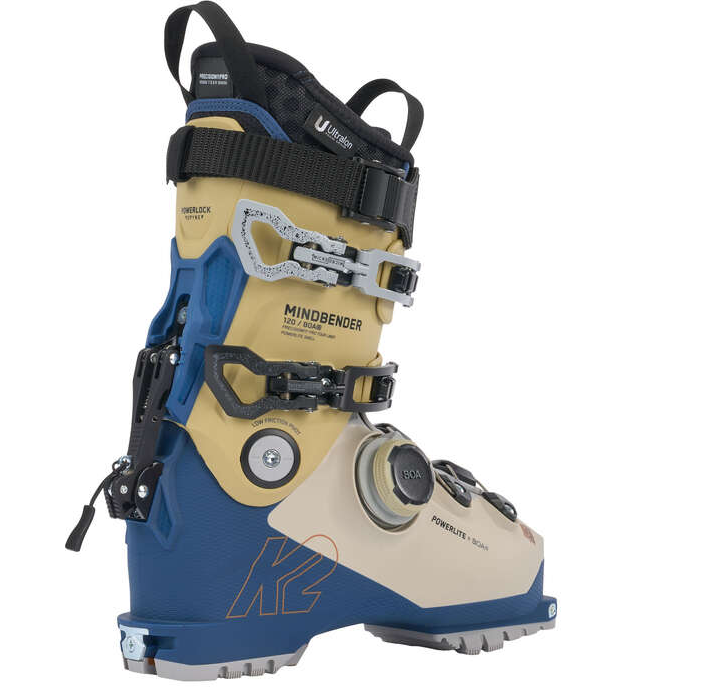
The K2 Mindbender 120 BOA is known for its comfortable and precise fit. The heat moldable Powerlite Shell and MultiFit Last can be customized to fit a variety of foot shapes, and the BOA Fit System provides micro-adjustable closure for a precise and even fit.
The boot also features a number of other features that contribute to its comfort, including:
- A wide toe box that provides plenty of room for the toes to wiggle
- A padded liner that provides cushioning and support
- A Powerlock Spyne walk mode that helps to prevent the boot from flexing too much while walking
Overall, the K2 Mindbender 120 BOA is a very comfortable boot, even for skiers with wide feet or other foot issues. It is also a relatively lightweight boot, which makes it easier to wear and hike in
Liner Material
The liner material of the K2 Mindbender 120 BOA is Ultralon® heat moldable closed-cell foam. This material is known for its comfort, durability, and performance. It is also relatively lightweight, which helps to keep the boot's overall weight down.
The liner is also designed to provide a precise and supportive fit. It features a number of features that contribute to its fit and performance, including:
- An asymmetric tongue that conforms to the shape of the foot
- A high-density power collar that provides support and power transfer
- A flex notch for increased range of motion while hiking
The Ultralon® liner in the K2 Mindbender 120 BOA is a major contributor to the boot's overall comfort and performance. It is a great choice for skiers who are looking for a boot that will keep them comfortable and supported all day long.
Here are some of the benefits of Ultralon® foam:
- It is heat moldable, which means that it can be customized to fit the exact shape of your foot.
- It is closed-cell foam, which means that it is resistant to water and moisture.
- It is durable and long-lasting.
- It is relatively lightweight.
- It provides excellent cushioning and support.
Overall, Ultralon® foam is a great choice for ski boot liners. It is comfortable, durable, and performance-oriented.
Closure System
The K2 Mindbender 120 BOA uses a BOA Fit System for closure. The BOA Fit System is a dial-based closure system that provides micro-adjustable closure for a precise and comfortable fit.
The BOA Fit System on the Mindbender 120 BOA features two dials: one for the lower boot and one for the upper boot. The lower dial controls the closure of the forefoot and instep, while the upper dial controls the closure of the shin and calf.
To close the boots, simply turn the dials until you achieve a desired fit. The dials can be turned in either direction to tighten or loosen the closure. To release the closure, simply pull up on the dials.
The BOA Fit System is a very popular closure system for ski boots, and it is known for its durability, reliability, and ease of use. It is also a very precise closure system, which allows you to achieve a custom fit for your foot.
Here are some of the benefits of the BOA Fit System:
- It is micro-adjustable, which allows you to achieve a precise and comfortable fit.
- It is durable and reliable.
- It is easy to use.
- It is fast to tighten and release.
- It is lightweight.
Overall, the BOA Fit System is a great choice for ski boot closures. It is precise, durable, reliable, and easy to use.
Sole Type
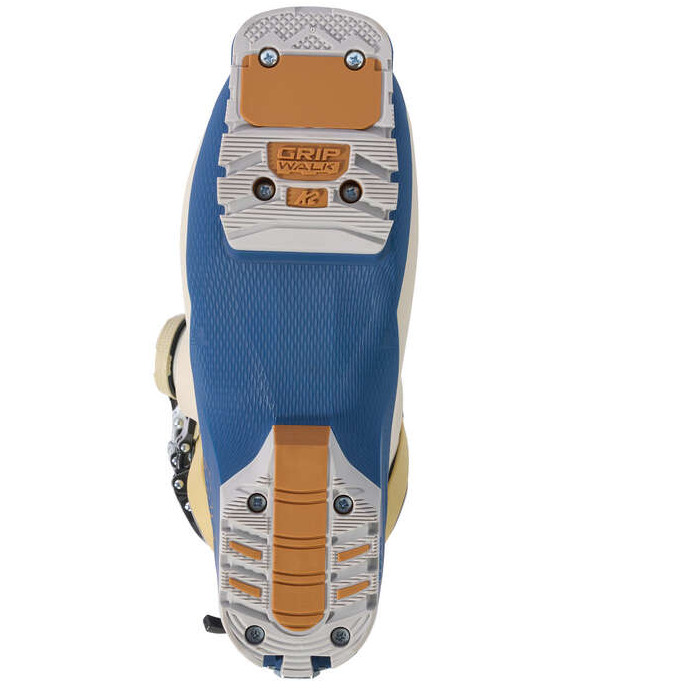
The K2 Mindbender 120 BOA has a GripWalk ISO 23223 sole. GripWalk soles are designed to provide better traction and comfort while walking and hiking, while still maintaining excellent power transfer while skiing.
GripWalk soles feature a rockered profile and a rubberized compound that provides better grip on hard surfaces, such as ice and pavement. They also have a wider tread surface, which provides more stability and support.
GripWalk soles are compatible with both alpine DIN bindings and touring bindings. However, it is important to note that not all alpine DIN bindings are compatible with GripWalk soles. If you are using alpine DIN bindings, be sure to check with the manufacturer to make sure that your bindings are compatible with GripWalk soles.
Overall, GripWalk soles are a great choice for skiers who are looking for a boot that provides both performance and comfort. They are particularly well-suited for skiers who do a lot of touring or backcountry skiing.
Boot Width and Last
The boot width and last of the K2 Mindbender 120 BOA are based on the medium width (MW) last, which has a width of 100 mm at the forefoot. This last is designed to fit skiers with average feet who do not need too much room or too much compression in their boots.
Weight
The weight of the K2 Mindbender 120 BOA is about 1675 grams per boot at size 26.5. This weight is relatively light for a boot with this level of performance and customization.
3) Nordica Cruise 120

The Nordica Cruise 120 is a high-performance ski boot with a wider last (104mm) to accommodate skiers with wide feet and higher insteps. It has a stiff flex (120) that provides excellent power and control, making it a good choice for advanced to expert skiers.
The Cruise 120 features a number of technologies that make it comfortable and supportive, even for long days on the slopes. The Primaloft® insulation helps to keep your feet warm, while the Performance Fit Liner is fully heat-moldable to provide a custom fit. The Instep Volume Control (IVC) system allows you to adjust the fit of the instep area in seconds.
Flex
The flex index of the Nordica Cruise 120 is 120, which means it is very stiff and responsive. It can handle high speeds and aggressive turns, but it also requires more strength and skill to control. The flex can also be adjusted by changing the position of the rear screw on the spine of the boot.
Fit and Comfort
The Nordica Cruise 120 is known for its comfortable and supportive fit. It has a wider last (104mm) than most ski boots, which makes it a good choice for skiers with wide feet and higher insteps.
The boot also features a number of technologies that make it more comfortable, including:
- Primaloft® insulation for warmth
- Performance Fit Liner that is fully heat-moldable for a custom fit
- Instep Volume Control (IVC) system to adjust the fit of the instep area
The Cruise 120 also has a number of features that make it supportive, including:
- Four-buckle overlap design with macro- and micro-adjustable buckles
- Adjustable Cuff Profile for a more comfortable fit and better hold
- 35mm Power Strap for support and improved control
Overall, the Nordica Cruise 120 is a very comfortable and supportive ski boot. It is especially well-suited for skiers with wide feet and higher insteps.
Here are some specific comments from skiers about the fit and comfort of the Nordica Cruise 120:
- "I have a wider foot, so the toe box gives me the extra room I need--nice fit and very comfortable."
- "Perfect boots. Amazing and comfortable. Really great purchase. Love them."
- "I'm a new skier and was nervous about 120's but they are comfortable and secure without any pain at all."
- "Really nice boots. I have a wider foot, so the toe box gives me the extra room i need--nice fit and very comfortable. The stiffness is 120 but has a nice feel--not too stiff and offers nice support. Overall, a great boot for the price."
Liner Material

The Nordica Cruise 120 uses a Performance Fit Liner. This liner is made from a combination of materials, including:
- Primaloft® insulation: Primaloft® is a synthetic insulation that is known for its warmth, even when wet. It is also lightweight and breathable.
- Heat-moldable foam: The foam in the Performance Fit Liner is heat-moldable, which means that it can be custom-fitted to your foot for a more precise and comfortable fit.
- Soft felts and linings: The soft felts and linings in the liner help to improve comfort and thermal properties.
The Performance Fit Liner is also designed to be supportive and secure. It has a reinforced heel construction and a plastic tongue for power transfer.
Overall, the liner material of the Nordica Cruise 120 is designed to provide comfort, support, and warmth. It is a good choice for skiers who are looking for a high-performance boot that is also comfortable for long days on the slopes.
Closure System
The Nordica Cruise 120 has a four-buckle overlap design with macro- and micro-adjustable buckles. The macro-adjustment allows you to quickly and easily adjust the overall fit of the boot, while the micro-adjustment allows you to fine-tune the fit for a more precise and secure feel.
The buckles are made from a durable and lightweight material, and they are easy to operate even with cold hands. They are also positioned to distribute pressure evenly across the top of your foot, which helps to prevent pressure points and discomfort.
The Nordica Cruise 120 also has a 35mm power strap. The power strap wraps around the top of the boot and helps to keep your foot in place and improve power transfer. The power strap is adjustable, so you can customize the fit to your liking.
Overall, the closure system of the Nordica Cruise 120 is well-designed and effective. It is easy to use and provides a secure and comfortable fit.
Sole Type
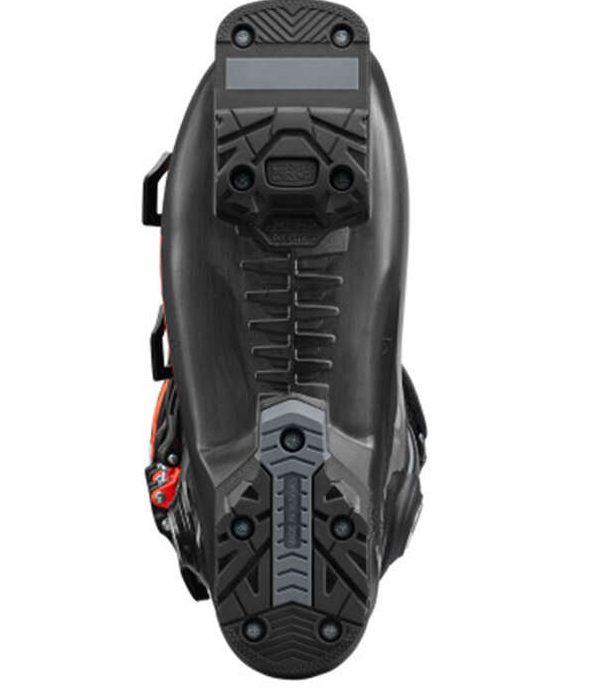
The Nordica Cruise 120 has GripWalk soles. GripWalk soles are designed to provide better traction and stability when walking off the slopes. They also have a rockered profile that makes it easier to walk and hike in ski boots.
GripWalk soles are compatible with GripWalk bindings. However, they can also be used with traditional alpine bindings using a GripWalk adapter.
Here are some of the benefits of GripWalk soles:
- Better traction and stability when walking off the slopes
- Rockered profile that makes it easier to walk and hike in ski boots
- Compatible with GripWalk bindings (and traditional alpine bindings with a GripWalk adapter)
Overall, GripWalk soles are a good choice for skiers who want a ski boot that is both high-performance and comfortable to walk in.
Boot Width and Last
The boot width and last of the Nordica Cruise 120 are based on the wide last, which has a width of 104 mm at the forefoot. This last is designed to fit skiers with wide and voluminous feet who need more room and comfort in their boots.
Weight
The weight of the Nordica Cruise 120 is about 2100 grams per boot at size 26.5. This weight is relatively heavy for a boot with this level of performance and customization.
4) Salomon Men's S/Pro Supra BOA 120
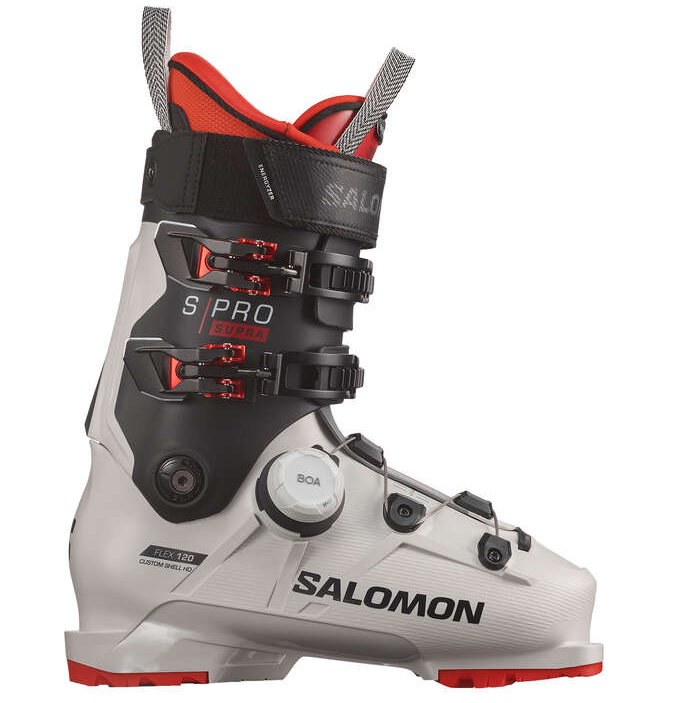
The Salomon Men's S/Pro Supra BOA 120 is a high-performance ski boot for advanced to expert skiers. It features a 120 flex rating, which makes it stiff enough to provide responsive power and control, but not so stiff that it's uncomfortable. The boot also has a 100mm last width, which is a good medium fit for most skiers.
One of the key features of the Salomon Men's S/Pro Supra BOA 120 is its BOA Fit System. This system replaces the traditional buckles on the forefoot with two BOA dials, which allow for micro-adjustable fit and precise pressure distribution. This helps to ensure that the boot fits snugly but comfortably, and that it provides the power transfer and support that advanced skiers need.
Another key feature of the Salomon Men's S/Pro Supra BOA 120 is its ExoWrap Construction. This construction utilizes a new shell and liner design that works in conjunction with the BOA Fit System to provide a more even and supportive wrap around the foot. This helps to improve power transfer and control, and it also reduces pressure points and hotspots.
Flex
The flex index of the Salomon S/Pro Supra BOA 120 is 120, which means it is very stiff and responsive. It can handle high speeds and aggressive turns, but it also requires more strength and skill to control. The flex can also be adjusted by changing the position of the rear screw on the spine of the boot.
Fit and Comfort
The Salomon Men's S/Pro Supra BOA 120 is designed to provide a precise and comfortable fit. The BOA Fit System allows for micro-adjustable fit and precise pressure distribution, which helps to ensure that the boot fits snugly but comfortably. The ExoWrap Construction also helps to improve the fit and comfort of the boot by providing a more even and supportive wrap around the foot.
In terms of comfort, the Salomon Men's S/Pro Supra BOA 120 features a number of comfort features, including:
- A fully dismantlable and customizable tongue that allows for perfect instep height adaptation.
- A slightly shaped, lightweight footbed made of special, lighter foams.
- A wide elastic section, located around the forefoot, that enhances wrapping when stepping into the boot.
- A Perf liner that brings foot wrapping to the next level thanks to the elastic belt around the forefoot and the new latex-foams layering offering snug foothold and precise steering.
Overall, the Salomon Men's S/Pro Supra BOA 120 is a well-fitting and comfortable ski boot. It is a good choice for skiers who are looking for a boot that provides both performance and comfort.
Liner Material
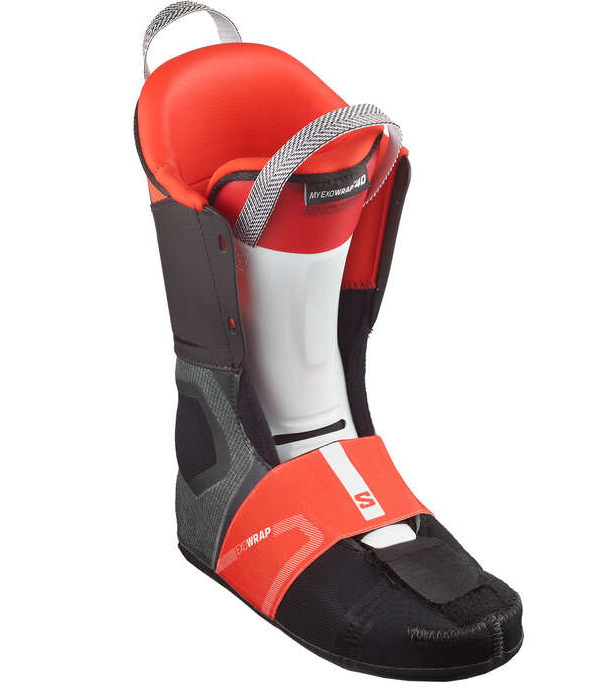
The liner material of the Salomon Men's S/Pro Supra BOA 120 is a combination of different materials, including:
- Latex foam: This type of foam is known for its soft and supportive properties. It is used in the liner to provide a snug and comfortable fit, as well as to help absorb shock and vibration.
- Memory foam: This type of foam conforms to the shape of your foot over time, providing a personalized fit. It is used in the liner around the heel and ankle to help prevent slippage and reduce pressure points.
- EVA foam: This type of foam is lightweight and durable. It is used in the liner to provide cushioning and support.
The liner is also covered in a soft, breathable fabric that helps to wick away moisture and keep your feet dry.
Overall, the liner material of the Salomon Men's S/Pro Supra BOA 120 is designed to provide a comfortable and supportive fit, as well as to help keep your feet dry and comfortable.
Closure System
The closure system of the Salomon Men's S/Pro Supra BOA 120 is a combination of the BOA Fit System and two traditional buckles.
The BOA Fit System replaces the traditional buckles on the forefoot with two BOA dials. These dials allow for micro-adjustable fit and precise pressure distribution. To tighten the boot, simply turn the BOA dials in the clockwise direction. To loosen the boot, turn the BOA dials in the counterclockwise direction.
The two traditional buckles are located on the upper cuff of the boot. These buckles help to secure the boot around the ankle and upper calf.
To put on the boot, first loosen the BOA dials and the buckles. Then, step into the boot and adjust the liner so that it is comfortable. Next, tighten the BOA dials until the boot is snug but not too tight. Finally, tighten the buckles until the boot is secure.
The BOA Fit System and the traditional buckles work together to provide a secure and comfortable fit for the Salomon Men's S/Pro Supra BOA 120.
Sole Type

The Salomon Men's S/Pro Supra BOA 120 has a GripWalk sole type. GripWalk soles are designed to provide better traction and comfort when walking on hard surfaces, such as concrete or ice. They have a rockered profile, which helps to roll the foot forward and makes it easier to walk. GripWalk soles are also compatible with GripWalk bindings, which provide a more direct connection between the boot and the ski for improved power transfer and performance.
GripWalk soles are a good choice for skiers who want a boot that is both comfortable and performant. They are especially beneficial for skiers who spend a lot of time walking on hard surfaces, such as on their way to and from the lift or when hiking to off-piste terrain.
Boot Width and Last
The boot width and last of the Salomon S/Pro Supra BOA 120 are based on the medium width (MW) last, which has a width of 100 mm at the forefoot. This last is designed to fit skiers with average feet who do not need too much room or too much compression in their boots.
Weight
The weight of the Salomon S/Pro Supra BOA 120 is about 1675 grams per boot at size 26.5. This weight is relatively light for a boot with this level of performance and customization.
5) Rossignol Speed 120 Ski

The Rossignol Speed 120 Ski is a high-performance ski boot for advanced to expert skiers. It features a stiff flex of 120 and a wide last of 104 mm, making it a good choice for skiers with wider feet or who prefer a more comfortable fit.
The Speed 120 is made with a polyurethane shell and cuff that is designed to be lightweight and responsive. It also features Sensor Matrix technology, which reinforces the boot in key areas for improved power transmission and control.
The liner in the Speed 120 is semi-customizable and can be thermoformed to the skier's foot for a personalized fit. The boot also has a number of features that make it easy to get in and out of, such as a wide entry design and four adjustable buckles.
Flex
The boot has a 120 mm flex, which is intended for skiers who can handle steep terrain and jumps. The flex can be adjusted with four micro-adjust aluminum buckles on the shell and cuff.
Fit and Comfort
The Rossignol Speed 120 Ski is designed to fit snugly but comfortably. It has a 104 mm last, which is wider than most average ski boots. This makes it a good choice for skiers with wider feet or who prefer a more relaxed fit.
The liner in the Speed 120 is semi-customizable and can be thermoformed to the skier's foot for a personalized fit. This is important because it helps to prevent pressure points and discomfort.
The boot also has a number of features that make it easy to get in and out of, such as a wide entry design and four adjustable buckles. The buckles are also micro-adjustable, so skiers can fine-tune the fit to their liking.
Overall, the Rossignol Speed 120 Ski is a comfortable ski boot that offers a good balance of support and flexibility. It is a good choice for skiers who are looking for a boot that can keep up with their aggressive skiing style without sacrificing comfort.
Liner Material
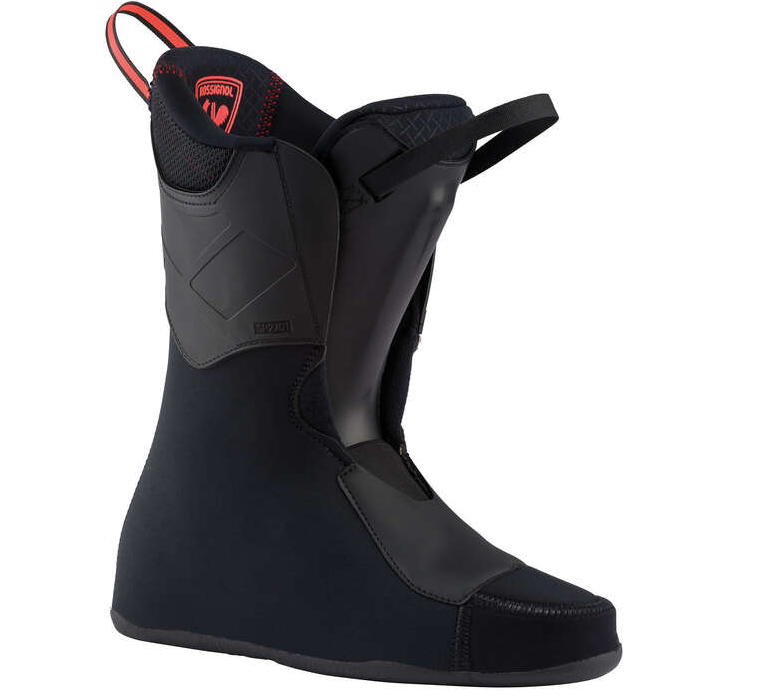
The liner of the Rossignol Speed 120 Ski is made of a mono-material polyethylene. This material is lightweight, durable, and thermoformable, which means that it can be molded to the skier's foot for a custom fit.
The liner also features dual-density 3D molded padding in key fit zones. This padding provides additional support and comfort in areas where it is needed most, such as the heel, ankle, and forefoot.
The liner is also insulated with Thinsulate® Stretch. This insulation helps to keep the skier's feet warm and comfortable in all conditions.
Overall, the liner of the Rossignol Speed 120 Ski is well-designed and provides a good balance of comfort and support. It is a good choice for skiers who are looking for a liner that will keep their feet warm and comfortable all day long.
Closure System
The Rossignol Speed 120 Ski has a four-buckle closure system. The buckles are made of aluminum and are micro-adjustable, so skiers can fine-tune the fit to their liking.
The top two buckles are located on the cuff of the boot and the bottom two buckles are located on the lower shell. The top buckles are responsible for closing the cuff around the skier's calf and the bottom buckles are responsible for closing the shell around the skier's foot.
The buckles are easy to use and can be operated with either hand. They are also designed to be durable and can withstand the rigors of skiing.
In addition to the four buckles, the Rossignol Speed 120 Ski also has a wide strap at the top of the cuff. This strap helps to keep the boot snugly in place and prevents it from slipping off.
Overall, the closure system on the Rossignol Speed 120 Ski is well-designed and provides a good balance of security and comfort. It is a good choice for skiers who are looking for a boot that will stay in place and provide good support during even the most aggressive skiing.
Sole Type
The Rossignol Speed 120 Ski has an Alpine DIN (ISO 5355) sole type. This is the most common type of sole for ski boots and is compatible with all Alpine ski bindings.
Alpine DIN soles are designed to provide a secure and responsive connection between the boot and the binding. They have a flat profile and hard plastic where they contact the binding for better power transmission and smooth, consistent releases.
The Rossignol Speed 120 Ski also has a toe and heel insert that is compatible with GripWalk soles. GripWalk soles are designed to make it easier to walk around in ski boots without slipping or tripping. They have a rubber tread that provides better traction on snow and ice.
However, it is important to note that GripWalk soles are not compatible with all Alpine ski bindings. Be sure to check your binding compatibility before purchasing GripWalk soles.
Boot Width
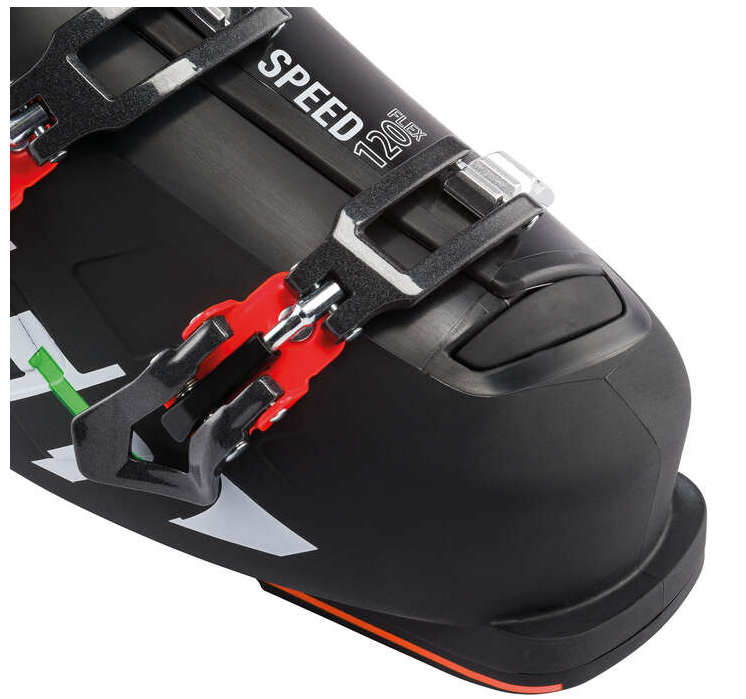
The boot has a medium width option, which fits most foot shapes comfortably.
Last
The boot has an ISO 5355 last, which is designed for alpine skiing on snow or ice.
Weight
The boot weighs 4.57 kg (10 lbs) without liner or bindings.
6) Atomic Hawx Prime 100
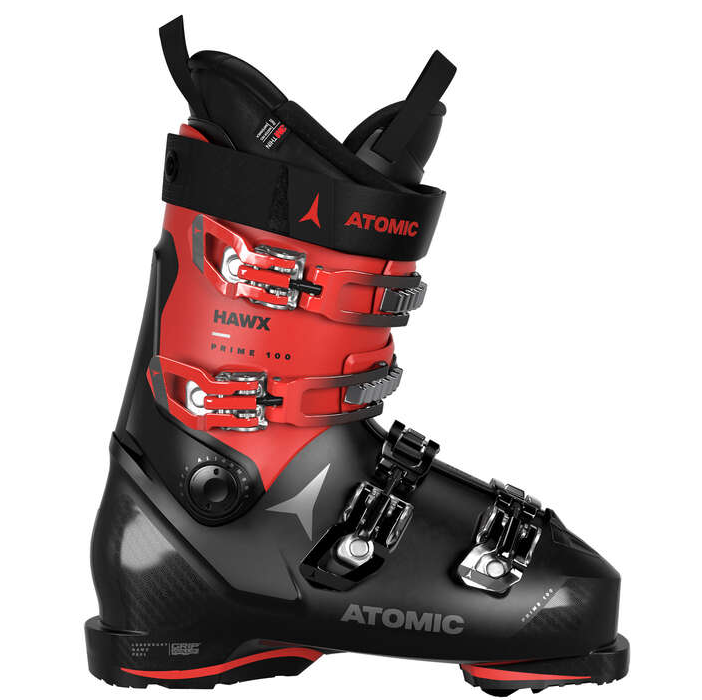
The Atomic Hawx Prime 100 is an all-mountain ski boot with a medium fit and flex. It is a good choice for intermediate to advanced skiers who are looking for a boot that is both comfortable and supportive.
The Hawx Prime 100 has a 100 mm last, which is a medium width. This makes it a good choice for skiers with medium-width feet. The boot also has a medium flex of 100, which provides a good balance of power and control.
The Hawx Prime 100 is made with Atomic's Prolite construction, which makes it lightweight and durable. The boot also has a Memory Fit liner that can be thermoformed to the skier's foot for a custom fit.
Overall, the Atomic Hawx Prime 100 is a well-designed ski boot that offers a good combination of performance and comfort. It is a good choice for intermediate to advanced skiers who are looking for a boot that can keep up with their aggressive skiing style without sacrificing comfort.
Flex
The Atomic Hawx Prime 100 has a medium flex of 100. This makes it a good choice for intermediate to advanced skiers who are looking for a boot that provides a good balance of power and control. The medium flex is also forgiving enough for skiers who are still developing their technique.
Fit and Comfort
The Hawx Prime 100 has a medium fit of 100 mm. This makes it a good choice for skiers with medium-width feet. The boot also has a pre-shaped 3D Gold liner that is designed to hug the foot comfortably. The liner can also be thermoformed to the skier's foot for a custom fit.
Liner Material
The liner in the Hawx Prime 100 is made of Ultralon. Ultralon is a lightweight and durable material that is also breathable and comfortable. The liner also features a Memory Fit process, which allows it to be molded to the skier's foot for a custom fit.
Closure System
The Hawx Prime 100 has a four-buckle closure system. The buckles are made of aluminum and are micro-adjustable, so skiers can fine-tune the fit to their liking. The buckles are also durable and can withstand the rigors of skiing.
Sole Type
The Hawx Prime 100 has an Alpine DIN (ISO 5355) sole type. This is the most common type of sole for ski boots and is compatible with all Alpine ski bindings.
Width
The Hawx Prime 100 has a medium width of 100 mm. This makes it a good choice for skiers with medium-width feet.
Last
The Hawx Prime 100 has a last of 100 mm. The last is the width of the boot at the widest point. A last of 100 mm is considered to be a medium width.
Weight
The Hawx Prime 100 weighs 1600 grams per boot. This is a relatively lightweight boot, which makes it comfortable to wear all day long.
7) K2 Method Ski Boot
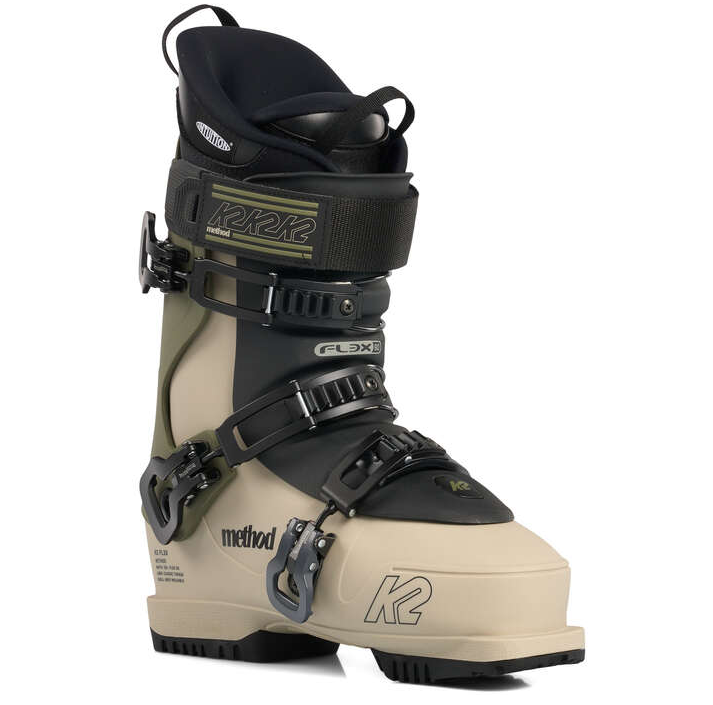
The K2 Method Ski Boot is a freestyle ski boot designed for skiers with a wider foot and a preference for a softer flex. It features a 102mm last and a 90 flex tongue, making it a great choice for skiers who want a comfortable and forgiving boot that can handle everything from the park to the pistes.
The Method Shell is made from a durable and lightweight material that provides good support and power transmission. The Intuition Tongue Liner is heat moldable and provides a custom fit around your foot. The GripWalk outsoles are compatible with both traditional alpine bindings and GripWalk bindings, making them easy to walk around in when you're not skiing.
Flex
The K2 Method Ski Boot has a flex rating of 90, which is considered a soft to medium flex. This makes it a good choice for skiers of all levels, from beginners to experts, and for a variety of skiing terrains. A softer flex boot provides more comfort and forgiveness, while a stiffer flex boot provides more power and precision.
Fit and Comfort
The K2 Method Ski Boot is designed to fit skiers with a wider foot. It has a 102mm last, which is wider than most other ski boots. The Intuition Tongue Liner is heat moldable, so it can be customized to fit your foot perfectly. This provides a snug and comfortable fit that reduces pressure points and blisters.
Liner Material
The Intuition Tongue Liner is made from a combination of heat-moldable foam and Intuition Wrap Liner. The heat-moldable foam conforms to the shape of your foot for a personalized fit. The Intuition Wrap Liner provides additional support and comfort in the ankle and instep areas.
Closure System
The K2 Method Ski Boot uses a four-buckle closure system. The buckles are made from durable aluminum and are easy to adjust. The closure system provides a secure and comfortable fit that keeps your foot in place while skiing.
Sole Type
The K2 Method Ski Boot has GripWalk outsoles. GripWalk outsoles are compatible with both traditional alpine bindings and GripWalk bindings. They have a rockered profile that makes it easier to walk around in your ski boots when you're not skiing.
Width
The K2 Method Ski Boot is available in a range of widths to fit a variety of foot shapes. The widths are:
- Narrow (100mm)
- Medium (102mm)
- Wide (106mm)
Last
The K2 Method Ski Boot has a 102mm last. This is a wider last than most other ski boots, so it's a good choice for skiers with wider feet.
Weight
The K2 Method Ski Boot weighs 3700 grams per pair. This is a relatively heavy ski boot, but it's important to note that weight is not always an indicator of performance or comfort.
8) Dalbello Panterra 100

The Dalbello Panterra 100 is an all-mountain ski boot designed for intermediate to advanced skiers. It has a medium flex rating (100) that provides a good balance of power and comfort, making it a versatile option for skiers who want to explore the entire mountain.
The Panterra 100 features Dalbello's Cabrio design, which consists of three separate pieces: the shell, the cuff, and the tongue. This design allows the boot to flex more naturally with the skier's leg, resulting in a more efficient and powerful transfer of energy to the ski.
Flex
The Dalbello Panterra 100 has a medium flex rating of 100. This makes it a versatile boot that is suitable for a variety of skiers, from intermediate to advanced. The 100 flex rating provides a good balance of power and comfort, allowing skiers to charge down the mountain while still maintaining a comfortable fit.
Fit and Comfort
The Panterra 100 features Dalbello's Cabrio design, which consists of three separate pieces: the shell, the cuff, and the tongue. This design allows the boot to flex more naturally with the skier's leg, resulting in a more efficient and powerful transfer of energy to the ski.
The Panterra 100 also features a heat-moldable liner that can be customized to the skier's foot for a precise fit. This helps to ensure that the boot is comfortable all day long, even on the longest days of skiing.
Liner Material
The Panterra 100 liner is made of a combination of Ultralon and Airlite materials. Ultralon is a high-quality foam that is known for its durability and comfort. Airlite is a lightweight foam that helps to reduce the overall weight of the boot.
The liner is also heat-moldable, which allows it to be customized to the skier's foot for a precise fit. This helps to eliminate pressure points and hot spots, making the boot more comfortable to wear.
Closure System
The Panterra 100 features a four-buckle closure system. The buckles are made of durable aluminum and have micro-adjustments for a precise fit.
The closure system is easy to use and provides a secure fit that will keep the skier's foot in place throughout the day.
Sole Type
The Panterra 100 features a GripWalk sole. GripWalk soles are compatible with both traditional alpine bindings and GripWalk bindings. They also have a rockered profile that provides improved traction when walking or hiking.
Width and Last
The Panterra 100 has a last width of 102-100 mm. This makes it a good choice for skiers with medium to wide feet.
Weight
The Panterra 100 weighs 1,850 grams per boot (size 26.5). This is a relatively average weight for an all-mountain ski boot.
9) Head Formula 110 MV
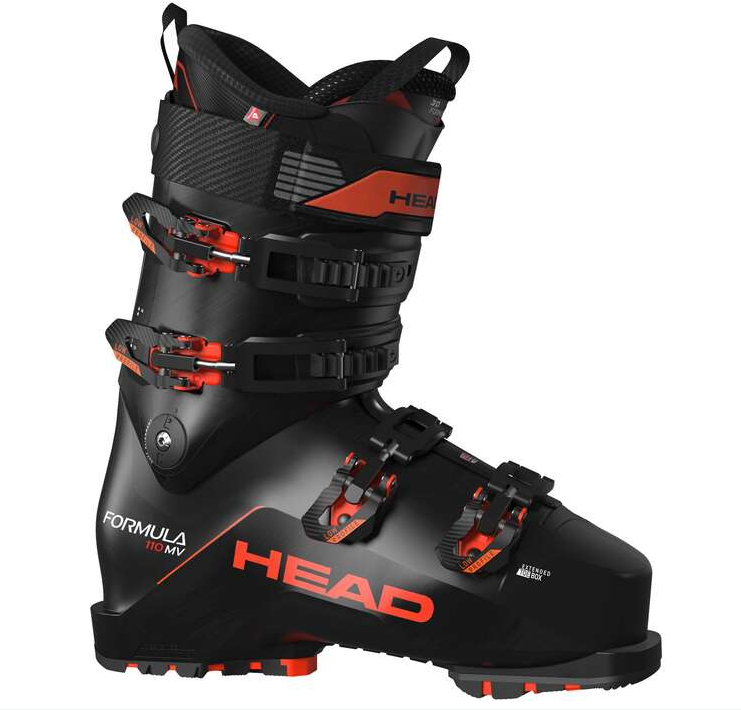
The Head Formula 110 MV is a high-performance ski boot that is designed for intermediate to advanced skiers. It has a flex rating of 110, which means that it is relatively stiff, providing good power transfer and control. The boot also has a medium width last, which makes it a good choice for skiers with average to slightly wider feet.
Flex
The Head Formula 110 MV has a flex rating of 110. This means that it is a relatively stiff boot, providing good power transfer and control. It is a good choice for intermediate to advanced skiers who are looking for a boot that can handle a variety of terrain and skiing styles.
Fit and Comfort
The Formula 110 MV is designed to provide a comfortable and precise fit. It features a Liquid Fit liner, which can be injected with foam to provide a custom fit around the ankle and heel pocket. The shell of the boot can also be heated and molded to the shape of your foot for a more personalized fit.
The Formula 110 MV also has a number of other features that contribute to its comfort, including:
- A wide last (100mm) that provides good toe room and prevents cramping.
- A soft tongue that reduces shin bang.
- A heat-moldable footbed that provides additional support and cushioning.
Liner Material
The Formula 110 MV features a Liquid Fit liner. This liner is made from a special foam that can be injected to provide a custom fit around the ankle and heel pocket. The Liquid Fit liner is also very comfortable and breathable, helping to keep your feet warm and dry all day long.
Closure System
The Formula 110 MV has a four-buckle closure system with micro-adjustment. This system provides a secure and comfortable fit, while also being easy to get in and out of.
Sole Type
The Formula 110 MV has GripWalk soles. GripWalk soles are made from a softer rubber compound than traditional alpine soles, providing better traction and walking comfort on hard surfaces.
Width
The Formula 110 MV has a medium width last (100mm). This makes it a good choice for skiers with average to slightly wider feet.
Last
The last is the shape of the inside of the ski boot. The Formula 110 MV has a medium width last (100mm). This means that the boot is wider in the forefoot and toe box than a narrow last boot, but not as wide as a wide last boot.
Weight
The Formula 110 MV weighs 1820 grams per boot (size 26.5). This is a relatively lightweight boot for its flex rating and performance.
10) Technica Cochise 120

The Tecnica Cochise 120 is a versatile alpine touring ski boot that is perfect for advanced to expert skiers who want to ski both on and off piste. It has a stiff 120 flex index that provides excellent power and precision, but it is also relatively lightweight and comfortable, making it ideal for long days in the backcountry.
Flex
The Tecnica Cochise 120 has a stiff flex index of 120. This means that it is a good choice for advanced to expert skiers who want a boot that provides plenty of power and precision.
Fit and Comfort
The Cochise 120 has a 99mm last, which is a medium forefoot width. This makes it a good fit for skiers with average to wide feet. The boot also has a C.A.S. liner, which is thermoldable for a custom fit. The C.A.S. liner is made of dual density micro-cell material, which is durable and supportive. It is also less prone to pack-out, so it will maintain its fit over time.
Liner Material
The Cochise 120 liner is made of dual density micro-cell material. This material is durable and supportive, and it is also less prone to pack-out. It is also thermoldable, so it can be customized to fit your foot perfectly.
Closure System
The Cochise 120 has a four-buckle closure system. The buckles are made of high-quality aluminum and are easy to adjust. The closure system provides a secure and supportive fit.
Sole Type
The Cochise 120 has a GripWalk sole. GripWalk soles are compatible with both alpine and touring bindings. They also have a rockered profile that makes it easier to walk in the boots.
Width and Last
The Cochise 120 has a 99mm last, which is a medium forefoot width. This makes it a good fit for skiers with average to wide feet.
Weight
The Cochise 120 weighs 1628 grams per boot (size 26.5). This is relatively lightweight for an alpine touring boot.
How To Choose Perfect Ski Boots
Choosing the right ski boots is crucial for your comfort, performance, and safety on the slopes. Here are some important factors to consider when selecting ski boots:
Boot Flex Rating
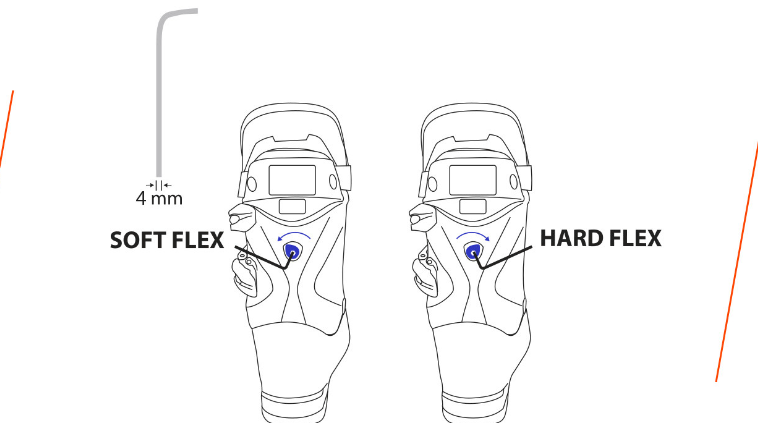
The flex rating of a ski boot is a crucial factor that determines its stiffness or flexibility. It's typically represented as a numerical value on a scale, with lower numbers indicating softer boots and higher numbers indicating stiffer boots. Understanding the boot flex rating is essential because it directly affects your skiing experience, control, and performance. Here's a more detailed look at this aspect:
a. Skiing Style and Ability Level:
The right flex rating largely depends on your skiing style and skill level. Different skiing disciplines and terrains may require varying levels of boot stiffness:
Beginners: If you're new to skiing, it's generally advisable to start with softer boots in the range of 60-80 flex. Softer boots are more forgiving and make it easier to initiate turns and control your skis. They are often more comfortable for those who are not yet used to the sport.
Intermediate Skiers: As you progress and become more confident on the slopes, you might consider boots in the 80-100 flex range. These offer a balance between support and flexibility, allowing you to improve your skills while maintaining control.
Advanced and Expert Skiers: Advanced skiers who enjoy skiing aggressively and tackling challenging terrain often prefer stiffer boots with flex ratings above 100. Stiff boots provide maximum power transfer and responsiveness, allowing for precision in carving turns and handling high-speed descents.
b. Body Weight and Strength:
- Your body weight and physical strength play a role in determining the appropriate flex rating. Heavier skiers may require stiffer boots to ensure proper support and responsiveness, while lighter skiers can opt for softer boots.
c. Terrain and Conditions:
- Consider the type of terrain you'll be skiing on most frequently. For example, if you mainly ski on groomed runs, you might lean towards slightly stiffer boots for better edge control. On the other hand, if you're into off-piste or backcountry skiing, you might appreciate a bit more flexibility for maneuverability in varied snow conditions.
d. Personal Preference:
- Ski boot flex is not an absolute rule but a guideline. Some skiers may have personal preferences that deviate from the standard recommendations. Some advanced skiers, for instance, may prefer slightly softer boots for a more playful and forgiving feel, especially in freestyle skiing.
e. Women-Specific Boots:
- Women's ski boots often have flex ratings adjusted to suit female skiers, taking into account their generally lower body weight and different biomechanics.
In summary, when considering the boot flex rating, it's essential to strike a balance between support and comfort based on your skiing style, ability level, body characteristics, and personal preferences.
Always try on multiple boots within the appropriate flex range to find the pair that feels most comfortable and suits your skiing goals. Consulting with a knowledgeable boot fitter can also provide valuable insights and recommendations tailored to your needs.
Skiing Ability
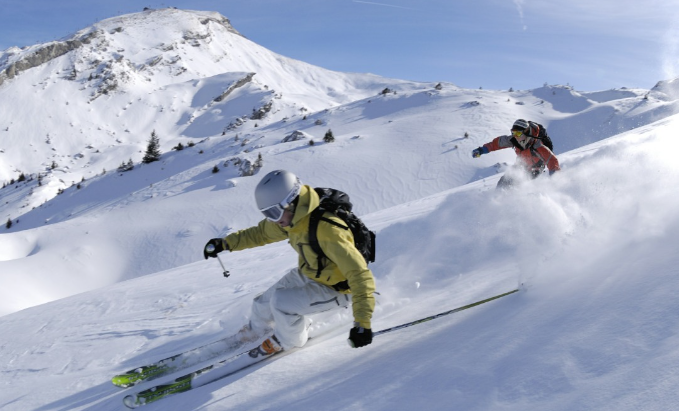
Skiing ability is one of the most critical factors to consider when selecting ski boots because it directly impacts your comfort, safety, and overall performance on the slopes. Your skill level as a skier will determine the type of boots that will best suit your needs. Here's how skiing ability factors into the decision-making process:
Beginner Skiers:
If you are new to skiing, you are likely still developing your skills and building your confidence on the mountain. As a beginner, you will benefit from ski boots that prioritize comfort and forgiveness.
Characteristics of boots for beginners include a softer flex rating (usually around 60-80) to make it easier to initiate turns and control your skis. These softer boots are more forgiving, which can help you maintain balance and reduce the likelihood of falling.
Intermediate Skiers:
Intermediate skiers have acquired basic skills and are comfortable on groomed runs. They might be exploring different types of terrain and working on refining their technique.
Boots for intermediate skiers typically offer a balanced combination of support and flex (around 80-100 flex rating). These boots provide enough control and responsiveness to help intermediate skiers progress while maintaining a comfortable fit.
Advanced Skiers:
Advanced skiers have honed their skills and are comfortable on various types of terrain, including ungroomed slopes, moguls, and powder. They may also enjoy skiing at higher speeds and more aggressively.
For advanced skiers, stiffer boots with flex ratings above 100 are often preferred. These boots offer greater responsiveness and precision, allowing for precise carving and control even in challenging conditions. Advanced skiers can handle the extra stiffness and leverage it for high-performance skiing.
Expert Skiers:
Expert skiers are highly skilled and experienced, often tackling the most challenging terrain and pushing the limits of their abilities.
Expert skiers may opt for the stiffest boots available, with flex ratings exceeding 130. These boots provide maximum power transfer and are essential for skiing at the highest levels of competition and in extreme conditions.
Adaptation for Specific Styles:
- Skiing ability also extends to your preferred style within the sport. For example, if you're into freestyle skiing, you might prioritize boots that allow for greater flexibility and mobility. Conversely, if you're into racing, you'll want boots that emphasize precision and control.
In summary, matching your skiing ability to the appropriate ski boot flex rating is crucial for comfort, safety, and performance. It ensures that your boots provide the right level of support and responsiveness for your skill level, allowing you to enjoy skiing to the fullest while also minimizing the risk of injury. Always remember that the right pair of ski boots can greatly enhance your skiing experience, so consult with a professional boot fitter who can assess your ability level and recommend the best options for you.
Boot Last Width
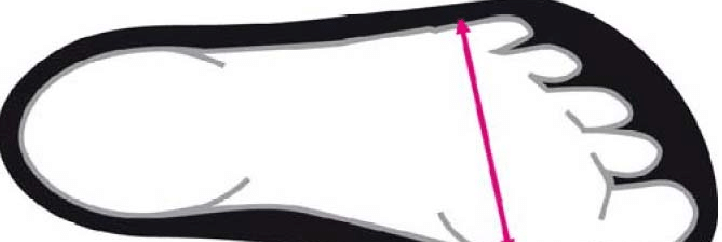
Boot last width is a crucial consideration when choosing ski boots, as it directly affects the fit and comfort of your boots, as well as your overall skiing experience. The last width refers to the width of the boot's shell at its widest point, typically measured in millimeters. Different boot last widths are designed to accommodate various foot shapes, and selecting the right width is essential for comfort and performance. Here's an in-depth look at boot last width:
Narrow Last (typically 98-100mm):
- Boots with a narrow last are designed for skiers with slim or narrow feet. These boots have a snug fit and offer excellent precision and control.
- Skiers with narrow feet often prefer narrow last boots because they provide a close and responsive fit, reducing the chance of foot movement inside the boot.
- Narrow last boots are commonly used in racing and high-performance skiing where control and power transmission are paramount.
Medium Last (typically 100-102mm):
- Boots with a medium last width are the most common and versatile choice for a wide range of skiers.
- They offer a balanced fit that accommodates many foot shapes, making them suitable for intermediate and recreational skiers.
- Medium last boots strike a good compromise between comfort and performance, making them suitable for a variety of skiing styles and skill levels.
Wide Last (typically 102mm+):
- Boots with a wide last width are designed for skiers with wider feet or those who prioritize comfort over precision.
- They provide extra room for skiers with broader forefeet, allowing for better comfort and circulation.
- Wide last boots are often chosen by skiers who experience discomfort or pressure points in narrower boots, particularly those who engage in all-day skiing or prioritize comfort in recreational skiing.
Gender-Specific Lasts:
- Many ski boot manufacturers offer gender-specific lasts. Women's ski boots, for example, often have narrower heel and ankle areas with a wider forefoot to better match the typical shape of a woman's foot.
- Gender-specific lasts aim to provide a more anatomically accurate fit and address the specific needs of male and female skiers.
Customization:
- Some ski boots come with heat-moldable liners and shells, allowing for a degree of customization. This feature can help fine-tune the fit of the boot to your foot shape, regardless of the last width.
Boot Fitting:
- It's crucial to visit a professional boot fitter when selecting ski boots, especially if you have specific foot shape requirements or issues like bunions or pronation.
- A boot fitter can measure your feet accurately and recommend boots that match your foot shape and address any potential fit issues.
Performance Considerations:
- Keep in mind that the last width also affects the performance of your ski boots. A narrower last provides better control and power transmission, while wider lasts prioritize comfort. Consider your skiing style and goals when choosing the appropriate last width.
In summary, the boot last width is a key factor in ensuring a comfortable and well-fitting ski boot. Selecting the right last width for your foot shape and skiing style can greatly enhance your skiing experience by improving comfort, control, and performance. Always consult with a professional boot fitter for personalized advice and a proper fitting process.
Boot Size
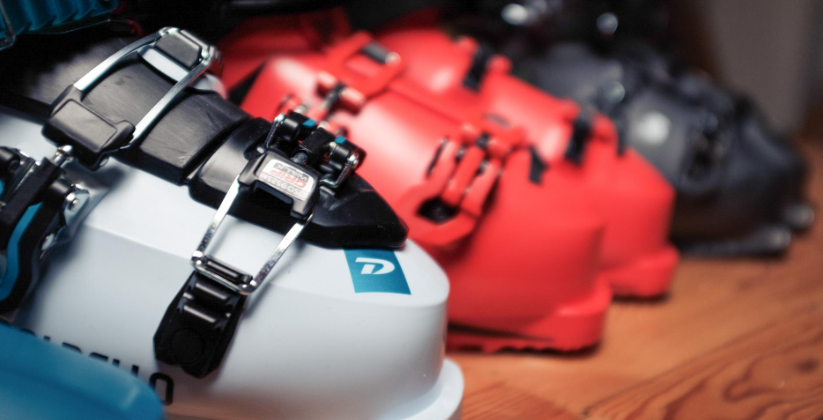
Choosing the correct boot size is crucial for ensuring comfort, control, and safety while skiing. Here's an in-depth look at considerations related to boot size:
Foot Measurement:
- Ski boot sizing is not the same as regular shoe sizing. To determine your correct ski boot size, start by having your feet measured by a professional boot fitter. They will measure both the length and width of your feet accurately.
Shell Size vs. Mondopoint Size:
Ski boots are typically sized using the Mondopoint system, which measures the length of your foot in centimeters. Your boot size is often labeled in Mondopoint sizes (e.g., 26.5 cm).
The shell size, which is the actual physical size of the boot's outer shell, corresponds to the Mondopoint size. It's crucial that the shell size is appropriate for your foot length. A professional boot fitter can help you verify this by placing your foot inside the shell with your toes lightly touching the front. There should be a small amount of space (about a finger's width) between your heel and the back of the shell.
Sizing Variations Between Brands:
- Keep in mind that ski boot sizing can vary between brands and even between different models from the same brand. Different manufacturers may use slightly different lasts (foot forms), so your size in one brand might not be the same in another.
Boot Flex and Size:
- The flex rating and size of the boot are interconnected. Generally, as the size of the boot increases, the stiffness of the boot may also increase. For example, a size 25 boot might have a different flex rating than a size 28 boot in the same model. Consider how the size and flex rating align with your skiing ability and style.
Fit and Comfort:
Ski boots should fit snugly but not be excessively tight. Your toes should lightly touch the front of the boot liner when you're standing up straight. This allows for proper control and minimizes foot movement inside the boot, which can lead to blisters and discomfort.
Pay attention to the width of the boot as well. Your foot should not feel overly compressed from the sides, but there should also not be excessive room that allows your foot to slide around.
Socks:
- Always wear the type of ski socks you intend to use on the slopes when trying on ski boots. Ski-specific socks are designed to wick moisture and provide cushioning in the right places.
Customization:
- Many ski boots offer customization options, such as heat-moldable liners and insoles. These features allow for a more tailored fit, accommodating specific foot shapes and addressing comfort issues.
Footbeds and Orthotics:
- If you have unique foot issues or require extra arch support, consider using custom footbeds or orthotics. These can significantly improve comfort and performance.
Professional Boot Fitting:
- Visiting a professional boot fitter is highly recommended. Boot fitters have the expertise and tools to assess your foot shape and biomechanics accurately. They can recommend the right size and model of boot and make necessary adjustments to ensure a precise fit.
In conclusion, choosing the correct ski boot size is a critical step in your skiing journey. A properly fitted boot enhances your control on the slopes, minimizes discomfort and the risk of injury, and ultimately contributes to a more enjoyable skiing experience. Remember that sizing varies between brands and models, so don't rely solely on shoe size; consult with a professional boot fitter to ensure you get the right size and fit for your individual needs.
Shell Material
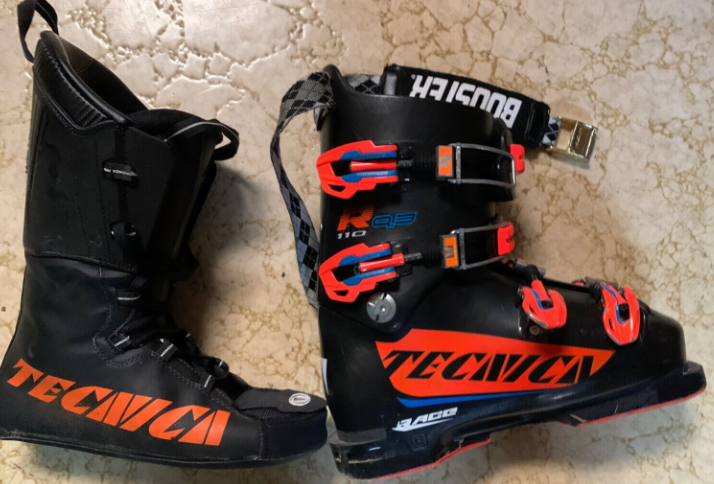
The shell material of ski boots is a crucial factor that impacts the boot's performance, weight, and durability. Understanding the various materials used in ski boot shells can help you make an informed choice when selecting the right pair of boots. Here's an in-depth look at ski boot shell materials:
Plastic Shells:
The vast majority of ski boots feature plastic shells. Polyurethane (PU) and polyether (PE) are the two primary types of plastics used in ski boot shells. These materials offer a balance of flexibility, stiffness, and durability.
Polyurethane (PU): PU is the most common shell material. It provides excellent stiffness, making it suitable for high-performance and racing boots. PU shells are also known for their durability and resistance to temperature changes.
Polyether (PE): PE shells are slightly lighter than PU and offer good stiffness. They are often used in high-performance and advanced-level boots. PE shells may be preferred by some skiers for their supple feel.
Plastic shells are known for their ability to maintain their shape and stiffness in varying temperatures, making them reliable for skiing in different conditions.
Carbon Fiber Shells:
Some high-end ski boots incorporate carbon fiber in their shell construction. Carbon fiber is exceptionally lightweight and strong, making it ideal for performance-oriented skiers. Boots with carbon fiber shells are often used in racing and other competitive disciplines.
Carbon fiber provides excellent power transfer, responsiveness, and precision. It allows for more energy transmission from your body to the ski edges, resulting in improved control and performance.
However, boots with carbon fiber shells tend to come at a premium price due to the advanced materials used.
Grilamid Shells:
Grilamid is a type of nylon-based thermoplastic that is increasingly being used in ski boot shells, particularly in lightweight touring and backcountry boots.
Grilamid offers a good balance of weight, stiffness, and durability. Boots with Grilamid shells are often sought after by skiers who prioritize uphill performance as well as downhill control.
These shells are lighter than traditional plastics, making them suitable for ski mountaineering and long tours. They are also known for being responsive in downhill skiing.
Pebax Shells:
Pebax is another lightweight and flexible thermoplastic material that is sometimes used in ski boot shells. It offers good energy absorption and flexibility, making it suitable for all-mountain and freeride boots.
Pebax shells can be molded more easily, which allows for customization and a precise fit.
Hybrid Shells:
Some ski boots feature hybrid shell constructions, which combine different materials in various parts of the boot. For example, a boot might have a stiffer plastic lower shell and a more flexible upper cuff.
Hybrid designs aim to provide a balance between comfort and performance. They can be particularly useful for skiers who want responsiveness in the lower part of the boot while maintaining comfort in the upper part.
In summary, the choice of ski boot shell material depends on your skiing style, ability level, and specific needs. High-performance skiers often opt for PU, carbon fiber, or Grilamid for maximum control and power transfer, while those who prioritize lightweight touring may prefer Grilamid or Pebax. Ultimately, selecting the right shell material is a matter of personal preference and the type of skiing you plan to do, so consider your specific requirements when choosing your ski boots.
Liner Material and Construction

The liner of a ski boot is the inner layer that surrounds your foot, providing cushioning, insulation, and a connection between your foot and the boot's shell. The liner material and construction are essential factors that influence comfort, warmth, and performance in ski boots. Here's an in-depth look at liner materials and construction:
Liner Material:
Foam Liners:
Foam liners are the most common type of liner material found in ski boots. They are made of various types of foam, including EVA (ethylene-vinyl acetate) and PU (polyurethane) foam.
Foam liners offer a balance of comfort and performance. They are often heat-moldable, allowing boot fitters to customize the fit by heating the liner and molding it to the shape of your foot for a precise fit.
These liners provide cushioning and insulation, helping to keep your feet warm and comfortable during a day of skiing.
Foam liners can be found in a range of ski boot models, from beginner to expert levels.
Thermoformable Liners:
Thermoformable liners are designed to be heat-molded to your foot shape. They are typically found in high-end ski boots.
These liners are made from materials that become pliable when heated, allowing for a more precise fit. This customization helps to eliminate pressure points and improve overall comfort.
Thermoformable liners often provide excellent energy transfer and responsiveness, making them suitable for advanced and expert skiers.
Intuition Liners:
Intuition liners are a popular aftermarket option for ski boot liners. They are known for their exceptional comfort and warmth.
Intuition liners are made from a closed-cell foam that is highly moldable and conformable. They are typically heat-molded by a professional boot fitter for a customized fit.
These liners are often used by serious skiers and those looking for the highest level of comfort and performance.
Custom Liners:
Some high-end ski boots come with custom liners that are specifically designed for that boot model. These liners are engineered to provide the best possible fit and performance when used with their corresponding shell.
Custom liners are often found in top-tier racing and performance-oriented boots.
Liner Construction:
Tongue Liners:
- Tongue liners have a separate tongue piece that allows for easy entry and exit from the boot. They provide a more traditional feel and are often found in alpine ski boots.
Wrap Liners:
- Wrap liners have a continuous, wrap-around design that envelops your entire foot. They provide a snug and precise fit and are commonly used in performance and race-oriented boots.
Overlap Liners:
- Overlap liners have a two-piece design that overlaps at the front of the boot. They provide a combination of comfort and performance and are often used in all-mountain and freeride boots.
Lace-Up Liners:
- Some liners have integrated lacing systems that allow you to further customize the fit and tension around your foot and lower leg.
Cuff Liners:
- Cuff liners extend higher up the leg and provide additional support, making them suitable for aggressive skiing and advanced skiers.
Dual or Multi-Layer Liners:
- Some liners have dual or multi-layer construction, which can provide enhanced insulation, moisture management, and cushioning.
In summary, the choice of liner material and construction should align with your skiing style, foot shape, and performance needs. It's essential to work with a professional boot fitter when selecting and customizing your boot liners to ensure the best possible fit and comfort. A well-fitted liner will not only enhance your skiing experience but also keep your feet warm and comfortable throughout your time on the slopes.
Boot Closure System
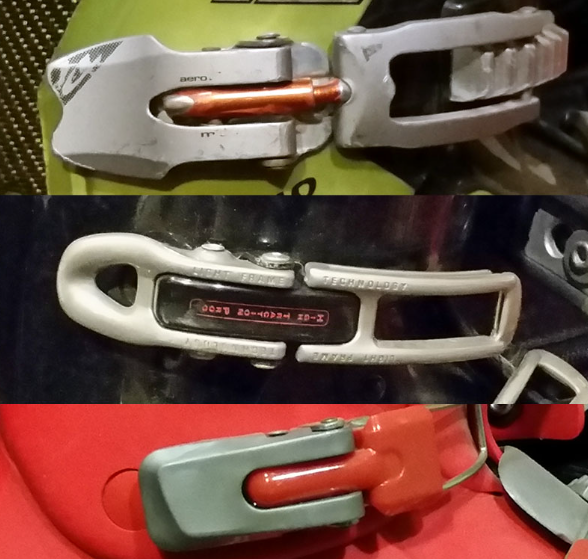
The closure system of a ski boot is the mechanism used to secure the boot onto your foot. It plays a crucial role in providing a secure fit, comfort, and control while skiing. There are several types of closure systems, each with its own advantages and considerations:
Traditional Buckles:
Traditional buckle systems are the most common type of closure system found on alpine ski boots. They consist of two to four buckles that fasten over the top of the foot and lower leg.
Each buckle can be adjusted to varying degrees of tightness, allowing for a customized fit. They provide good control over the pressure exerted on different parts of the foot.
Traditional buckles are durable and reliable, making them a popular choice for all levels of skiers.
BOA Lacing System:
The BOA system uses a dial and steel cables to tighten the boot. The dial allows for precise, micro-adjustable control over the fit.
BOA systems are known for their quick and easy entry and exit. They distribute pressure evenly across the foot, reducing the likelihood of pressure points.
BOA systems are often found in high-performance and backcountry ski boots.
Laces and Power Straps:
Some ski boots, particularly those used in backcountry and touring, feature a combination of laces and power straps.
Laces provide a customizable and even pressure distribution across the foot. Power straps, located at the top of the boot's cuff, add additional support and stability.
This combination allows for a secure fit while still providing flexibility and ease of movement.
Velcro Power Straps:
Power straps are wide bands of Velcro or other hook-and-loop materials that secure across the top of the boot's cuff.
They provide additional support and help distribute pressure more evenly. Power straps are often used in conjunction with other closure systems.
Overlap or Tongue Closure:
Boots with an overlap or tongue closure system have a flexible tongue that opens to allow for easy entry and exit.
The tongue is secured with buckles, laces, or a combination of both. This design provides a snug and secure fit around the foot and lower leg.
Walk Modes and Touring Systems:
- Some ski boots, especially those designed for backcountry and touring, feature specialized closure systems that allow for a "walk mode." This mode increases flexibility for easier walking and climbing, and it's often combined with different types of buckles or lacing systems.
Customizable Closure Systems:
Some high-end boots come with customizable or heat-moldable liners and shells. These systems allow for a precise fit by molding the boot to the shape of your foot.
This can greatly enhance the effectiveness of the chosen closure system.
In conclusion, the choice of closure system depends on your skiing style, preferred terrain, and personal preferences. It's important to try on several pairs of boots and test the closure system to ensure that it provides a secure and comfortable fit. Consulting with a professional boot fitter can also help you choose the best closure system for your specific needs. Remember that a properly fitting boot with an appropriate closure system is essential for an enjoyable and safe skiing experience.
Compatibility
Ski boot compatibility refers to the ability of your ski boots to work seamlessly with your ski bindings and, by extension, your skis. Ensuring compatibility is essential for safety, performance, and control when skiing. Here's a detailed explanation of the various aspects of ski boot compatibility:
Binding Type Compatibility:
Alpine Ski Bindings: These bindings are designed for downhill skiing on groomed slopes. Alpine ski boots have a standard ISO 5355 norm, and they are compatible with alpine bindings.
Touring Ski Bindings: These bindings are used for backcountry and touring skiing. They require a compatible boot with tech inserts (also known as Dynafit inserts or pin inserts) in the toe and heel areas. Touring boots often have tech-compatible fittings, making them suitable for these bindings.
Telemark Ski Bindings: Telemark bindings are specific to the telemark skiing style. Telemark boots have a duckbill shape and a 75mm norm, while the bindings have corresponding toe and heel pieces. Ensure your boots and bindings match in terms of the 75mm norm for compatibility.
Snowboard Bindings: Some snowboarders use ski boots with snowboard bindings. These boots need to have a compatible sole that can securely attach to the snowboard bindings. Make sure your boots are designed for this dual-purpose use.
Binding Release Settings:
- Alpine ski bindings have adjustable release settings to prevent injury during a fall. These settings are based on your weight, skiing ability, and boot sole length. It's crucial to have your bindings professionally adjusted by a certified technician to ensure they release correctly when needed.
Boot Sole Compatibility:
Ski boot soles vary in design and thickness depending on the type of skiing they are intended for. Alpine ski boots have thick, flat soles for optimal power transmission, while touring boots have rockered soles for walking. Ensure your boot sole type matches the binding type.
Alpine ski bindings require boot soles with compatible toe and heel shapes for proper retention and release. Alpine touring bindings often have adjustable AFDs (Anti-Friction Devices) to accommodate different sole types.
Boot Size Compatibility:
- Ski bindings come in various sizes to accommodate different boot sole lengths. Ensure your bindings are adjusted to fit your specific boot size. This is usually done by a professional technician when you purchase the bindings.
Ski Compatibility:
- Your ski boots should also be compatible with your skis. Skis have binding mounting points and brake widths that should match the bindings you intend to use. Check that your bindings fit the skis and that the brakes (if equipped) are appropriately sized to prevent interference with the ski edges.
Binding Mounting Position:
- The mounting position of your bindings on your skis can affect your skiing performance. Ensure that your bindings are mounted in the recommended position, which is usually marked on the ski by the manufacturer. This ensures that your boots interact with the skis optimally.
Consult with Professionals:
- It's advisable to consult with a certified ski technician or boot fitter to ensure proper compatibility between your boots, bindings, and skis. These professionals have the expertise and tools to make necessary adjustments and recommendations for a safe and enjoyable skiing experience.
In summary, ensuring compatibility between your ski boots, bindings, and skis is essential for safety and performance on the slopes. Mismatched equipment can lead to unstable skiing, increased risk of injury, and a less enjoyable experience. Always consult with professionals when in doubt about compatibility, and have your bindings professionally adjusted to your specific needs and abilities.
Comfort and Fit
Comfort and fit are paramount when it comes to ski boots. Ill-fitting boots can lead to discomfort, pain, and even injury. Here's an in-depth exploration of these critical aspects:
Comfort:
Toe Box Comfort:
- The toe box should provide enough room for your toes to wiggle slightly without being cramped. A tight toe box can lead to discomfort, numbness, and even frostbite in extreme conditions.
Heel and Ankle Comfort:
- The heel and ankle should be snugly held in place without excessive pressure points. If your heel is lifting or moving inside the boot, it can lead to blisters and loss of control.
Calf and Shin Comfort:
- The boot's upper cuff should cradle your calf comfortably without causing excessive pressure. If the cuff is too tight, it can lead to shin bang or pressure points on your calf.
Arch Support:
- A well-fitted boot should provide good arch support. This helps distribute pressure evenly across your foot, reducing fatigue and discomfort.
Liner Padding and Material:
- The liner should be well-padded and made from a comfortable material. Look for liners that offer sufficient cushioning without causing excessive pressure points.
Moisture Management:
- Good ventilation and moisture-wicking properties in the liner help keep your feet dry and comfortable, especially during intense skiing sessions.
Fit:
Length:
- Your toes should lightly touch the front of the boot when you're standing up straight. This ensures that your foot is not sliding forward during skiing, which can lead to discomfort and a lack of control.
Width:
- The boot should snugly cradle your foot without excessive pressure points. It shouldn't be too tight or too loose. If the boot is too narrow, it can lead to discomfort and circulation issues. If it's too wide, you may lack control over your skis.
Heel Hold:
- Your heel should sit securely in the boot without lifting or moving during skiing. A secure heel hold is crucial for control and responsiveness.
Instep Fit:
- The instep area should comfortably secure your foot without excessive pressure. This ensures that the boot provides adequate support and control.
Customization Options:
- Some ski boots come with features that allow for customization, such as heat-moldable liners and shell materials. These can be beneficial for achieving a precise fit.
Flex and Stiffness:
- The boot's flex rating should match your skiing ability and style. A flex that's too stiff or too soft for your skill level can lead to discomfort and reduced control.
Consult a Professional:
- Visiting a professional boot fitter is highly recommended. They have the expertise and tools to accurately measure your feet, assess your specific needs, and make necessary adjustments to ensure a precise and comfortable fit.
Remember, finding the right fit may require trying on multiple pairs of boots and seeking the advice of a professional. A well-fitted and comfortable pair of ski boots is essential for an enjoyable, safe, and high-performance skiing experience.
Budget
Setting a budget is a crucial step when purchasing ski gear, as skiing can be an expensive sport. Your budget will determine the quality and type of equipment you can afford, and it should align with your skiing goals, frequency, and personal financial situation. Here's an in-depth exploration of budget considerations for skiing:
Assess Your Financial Situation:
- Start by evaluating your overall financial health. Determine how much you can comfortably allocate to skiing without straining your finances or neglecting other important financial responsibilities.
Determine Your Skiing Goals:
- Consider your skiing aspirations. Are you a beginner looking to try skiing for the first time, an occasional skier who hits the slopes a few times a season, or a dedicated enthusiast who plans to ski regularly and progress in the sport? Your goals will influence your budget.
Break Down Expenses:
- Understand the various expenses associated with skiing, including equipment, lift tickets, lessons, accommodations, travel, and clothing. Allocate your budget accordingly to cover all these aspects.
Prioritize Safety and Comfort:
- While budgeting, prioritize items that directly impact safety and comfort, such as ski boots and helmets. A well-fitted pair of boots is arguably the most critical investment, as they affect your skiing performance and safety.
Consider Used or Rental Equipment:
- If you're on a tight budget or just getting started, consider buying used equipment or renting. Many ski resorts offer rental packages that include skis, boots, and poles, which can be cost-effective, especially for occasional skiers.
Understand the Value of Quality:
- High-quality ski gear typically lasts longer and provides better performance and comfort. While it may be tempting to opt for the cheapest options, investing in durable, well-designed equipment can save you money in the long run by reducing the need for frequent replacements or upgrades.
Budget for Lessons:
- If you're new to skiing or want to improve your skills, budget for lessons with a certified instructor. Proper instruction can enhance your experience and safety on the slopes.
Plan for Season Passes:
- If you intend to ski regularly at a specific resort, consider purchasing a season pass, which can provide significant savings over daily lift ticket purchases.
Travel and Accommodation:
- If you're planning trips to ski resorts, budget for travel expenses, accommodations, and meals. Keep in mind that resort towns can be expensive, so plan accordingly.
Emergency Fund:
- It's essential to have some financial flexibility within your budget for unexpected expenses or emergencies, such as medical costs or equipment repairs.
Consider Long-term Savings:
- If skiing is a long-term passion, consider budgeting for more durable equipment and taking advantage of offseason sales and deals.
Financial Goals:
- Ensure that your skiing budget aligns with your broader financial goals, such as saving for retirement, paying off debt, or saving for other priorities.
Be Realistic:
- Your budget should be realistic and sustainable. Don't overspend on skiing to the detriment of your overall financial well-being.
Remember that your skiing budget is a personal decision and should reflect your unique circumstances and priorities. By carefully planning and allocating your budget, you can enjoy the sport of skiing while maintaining your financial health and security.
Wrapping Things Up
In conclusion, the journey to finding the perfect ski boots is an adventure in itself, and it's one that every skier should embark upon with care and consideration. We've explored the top ski boots available today, each catering to different needs, abilities, and styles on the mountain.
From the precision and power of expert-level boots to the comfort and ease of use for beginners, there's a pair of ski boots waiting to elevate your skiing experience. Whether you're carving down groomed slopes, tackling challenging off-piste terrain, or venturing into the backcountry, the right pair of boots can make all the difference.
Remember that your choice of ski boots should align with your skill level, skiing ambitions, and the unique shape of your feet. And while technology has undoubtedly advanced the world of ski gear, there's no substitute for a visit to a professional boot fitter who can tailor the fit to your individual anatomy.
Ultimately, the top ski boots for you are the ones that make you feel at one with the mountain. They provide the perfect blend of comfort, control, and performance, ensuring that every moment on the slopes is a pure delight. So, whether you're an aspiring skier or a seasoned pro, invest wisely in your ski boots, and you'll be on your way to unforgettable adventures in the snow. Happy skiing!
